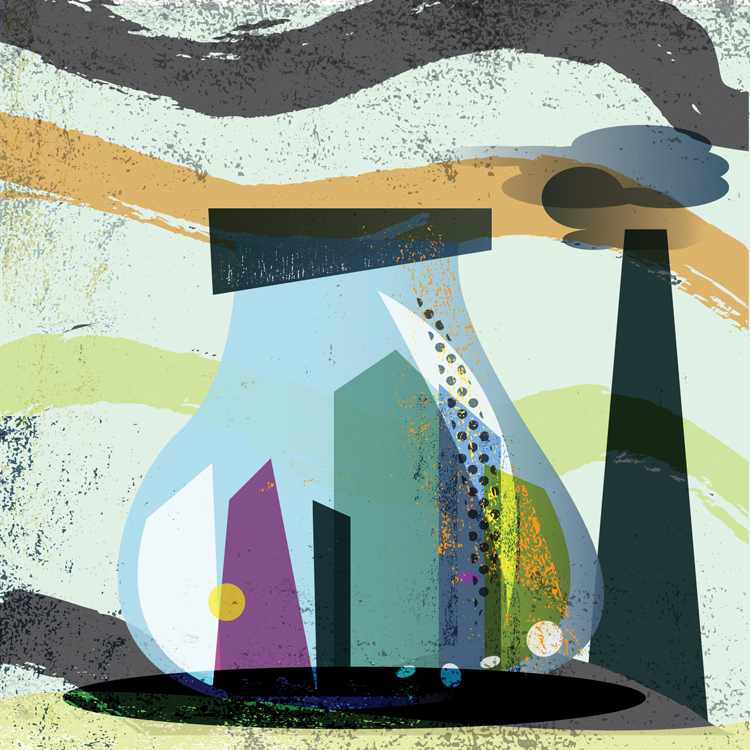Illustration by Shawn Hileman
Philadelphia, We Have a Solution
interview by Heather Shayne Blakeslee
Matthew Tejada, a former clean air advocate in Houston, is now the director of the Office of Environmental Justice at the U.S. Environmental Protection Agency. Tejada spoke with Grid about his trajectory from community organizer to federal appointee, lessons learned along the way, and the link among strong environmental regulation, public health and a thriving economy.
There are forces in Philadelphia that would like to make us the next Houston. You were involved in helping to ensure that the petrochemical industry kept environmental and public health in mind in their operations in your work at Air Alliance Houston. What were some of the environmental justice issues in Houston around this work?
MT: Houston is the largest energy hub in the entire United States, and the immensity of heavy industry there can be overwhelming: oil, chemicals, petrochemicals, manufacturing, shipping, transportation, storage, agriculture, technology, medicine, aerospace. Houston also has no zoning or traditional form of city planning to speak of, both elements that are essential to its personality as a “make it happen if you can” kind of town.
It’s also, by at least one measure, the most diverse city in the entire country, but those populations tend to be very segregated. There are a lot of reasons for this; whether as a result of historic policies such as redlining or more recent immigration trends and socioeconomic pressures, along with having very few space constrictions in a city of its size, Houston is very much a community of separate communities. So, you have all of this industry in all of its different stripes—a huge, sprawling metropolis. And that’s combined with all of the minor sources of pollution and environmental threats.
Taken with extraordinary diversity—and also stark segregation and separation of different populations—there are no end to challenges and no end to opportunities to work on issues that can have a real positive impact on people’s lives. So many issues there are big, and have national connections and implications, but at the same time are hyperlocal.
What should Philadelphia be on the lookout for?
MT: The biggest lesson to me is that engagement, relationship building and collaboration are absolutely crucial. Those are central to everything we do with environmental justice here at EPA, and they were lessons I learned first-hand working around the Texas Gulf Coast. It was really illuminating to me during my time there because I worked with a lot of different communities from Port Arthur to Corpus Christi; and each community, of course, was completely unique and different, but, at the same time, they all had the same issues and actors involved.
But the places that were making progress were always the places where, at the end of the day, folks could talk to one another. They could walk around the corner to actually look at and have a conversation about the problem and what they might be able to do about it. That doesn’t mean they always agreed. Everyone understood when they went back to their separate places that some would draft lawsuits and others would get ready for quarterly earnings meetings and others to fundraise for their next election. But they were able to talk and search for areas of commonality, so they could collaboratively move the ball forward and actually make change happen.
What were the challenges of working with the petrochemical industry?
MT: Folks understanding one another. Being able to build relationships and trust with folks from industry is one of the things I’m most proud of from my time in Houston, and also one of the most valuable things that I learned. It doesn’t matter who you are or what side you’re coming from— just about everyone walks into a room and has a preconceived notion about what everyone else is walking into that room looking for. And it’s hard. But it’s absolutely essential that folks don’t become preoccupied with those notions.
Just because someone comes in representing industry doesn’t mean they are a bad person; they’re human beings like everyone else there, and their job is to represent the business interest of the company they work for. The community members, likewise, are human beings who are looking out for the best interests of their families and communities. That sets up a complicated dynamic, of course, because you have one side looking very pragmatically at their economic interest, and the other side looking very passionately at the health of their children and the value of their homes. But those interests do not have to be incompatible with one another.
It’s really incredible when you actually see places in this country where folks have gotten past these notions and start to work together. It’s not some big love fest and everyone is best friends and spends their holidays together—there are still tense interactions and tough conversations and plenty of confrontations, but when they have gotten to the point that after the confrontation they can take a breath and restart the conversation, those places can really start to do good things with and for the community.
Can you talk about some of the community organizing strategies that were successful, or things you might have done differently?
MT: I went into community organizing and working on the community level as a complete unknown. I had studied social movement theory and the role of civil society as academic disciplines, but when I got to Houston, all of a sudden there was a community in front of me that needed help. I really had no idea what to do other than to start showing up, talking to people, and then promising that I’d show up again next week. And it took some time and I definitely made my share of mistakes along the way, but there are some basic things I learned which, no surprise, plenty of other people have learned and been sharing as central truths for decades before I ever showed up.
One is that the community speaks for itself—it doesn’t need someone else speaking for it. Another is that you can’t show up and want the community to just work on your issue. If you want to work with the community, you have to engage them and try to do what you can on all of their issues. In Houston, my organization would partner with communities, because we were focused on air quality and health, but we wound up working on issues of education, health care access, transportation and transit, local food, land use decisions—all sorts of things. Because if they were going to partner with us and raise their voices for air quality improvements, then my organization had to be willing to partner with them and raise our voices for a different bus stop and a new grocery store.
This is the hardest work you can do. Engaging a community, being a partner, doing the legwork, showing up every time, building trust and keeping that trust, putting your heart and passion into it—and dealing with all of the struggles and challenges—is absolutely the hardest work there is. But it’s also the most meaningful and rewarding when you do it right.
Countries like China and India, which don’t have the protection of laws like the Clean Water Act or Clean Air Act, are really suffering. How directly linked are America’s environmental protections to our economy?
MT: At the EPA, we think that the choice offered between environmental protection or a healthy economy is a false choice. Since 1970, air pollution has decreased by nearly 70 percent while the economy has tripled in size. The economic benefits of protecting health and the environment, based upon sound science, while provid
ing an even playing field for industry, has time and again proven to be a winning combination for our country, its people and our economy.
Are we just exporting our pollution as manufacturing moves abroad?
MT: We are also a global leader in protecting the environment and health. EPA Administrator Gina McCarthy has called for a new era of partnerships at the agency. Just this past year, our head of enforcement and compliance spent two weeks in China and Thailand for this very purpose—to share with our partners what we have learned and where we are headed, and why it is such a benefit to the health and economic prosperity of our country. Our environment in the U.S. is a part of the global environment, and it takes partnerships and collaboration to protect it.
Matthew Tejada is director of the Office of Environmental Justice at the U.S. Environmental Protection Agency.







